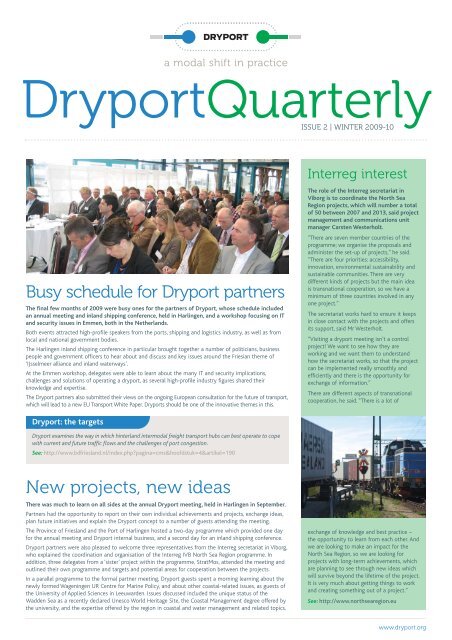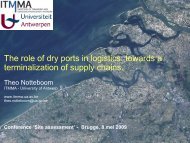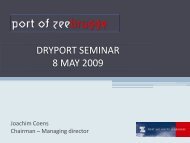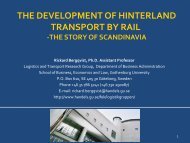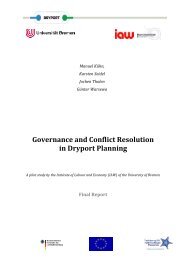Dryport Quarterly 2 - Interreg IVB North Sea Region Programme
Dryport Quarterly 2 - Interreg IVB North Sea Region Programme
Dryport Quarterly 2 - Interreg IVB North Sea Region Programme
You also want an ePaper? Increase the reach of your titles
YUMPU automatically turns print PDFs into web optimized ePapers that Google loves.
a modal shift in practice<strong>Dryport</strong><strong>Quarterly</strong>ISSUE 2 | WINTER 2009-10<strong>Interreg</strong> interestBusy schedule for <strong>Dryport</strong> partnersThe final few months of 2009 were busy ones for the partners of <strong>Dryport</strong>, whose schedule includedan annual meeting and inland shipping conference, held in Harlingen, and a workshop focusing on ITand security issues in Emmen, both in the Netherlands.Both events attracted high-profile speakers from the ports, shipping and logistics industry, as well as fromlocal and national government bodies.The Harlingen inland shipping conference in particular brought together a number of politicians, businesspeople and government officers to hear about and discuss and key issues around the Friesian theme of‘IJsselmeer alliance and inland waterways’.At the Emmen workshop, delegates were able to learn about the many IT and security implications,challenges and solutions of operating a dryport, as several high-profile industry figures shared theirknowledge and expertise.The <strong>Dryport</strong> partners also submitted their views on the ongoing European consultation for the future of transport,which will lead to a new EU Transport White Paper. <strong>Dryport</strong>s should be one of the innovative themes in this.The role of the <strong>Interreg</strong> secretariat inViborg is to coordinate the <strong>North</strong> <strong>Sea</strong><strong>Region</strong> projects, which will number a totalof 50 between 2007 and 2013, said projectmanagement and communications unitmanager Carsten Westerholt.“There are seven member countries of theprogramme; we organise the proposals andadminister the set-up of projects,” he said.“There are four priorities: accessibility,innovation, environmental sustainability andsustainable communities. There are verydifferent kinds of projects but the main ideais transnational cooperation, so we have aminimum of three countries involved in anyone project.”The secretariat works hard to ensure it keepsin close contact with the projects and offersits support, said Mr Westerholt.“Visiting a dryport meeting isn’t a controlproject! We want to see how they areworking and we want them to understandhow the secretariat works, so that the projectcan be implemented really smoothly andefficiently and there is the opportunity forexchange of information.”There are different aspects of transnationalcooperation, he said. “There is a lot of<strong>Dryport</strong>: the targets<strong>Dryport</strong> examines the way in which hinterland intermodal freight transport hubs can best operate to copewith current and future traffic flows and the challenges of port congestion.See: http://www.bdfriesland.nl/index.php?pagina=cms&hoofdstuk=4&artikel=190New projects, new ideasThere was much to learn on all sides at the annual <strong>Dryport</strong> meeting, held in Harlingen in September.Partners had the opportunity to report on their own individual achievements and projects, exchange ideas,plan future initiatives and explain the <strong>Dryport</strong> concept to a number of guests attending the meeting.The Province of Friesland and the Port of Harlingen hosted a two-day programme which provided one dayfor the annual meeting and <strong>Dryport</strong> internal business, and a second day for an inland shipping conference.<strong>Dryport</strong> partners were also pleased to welcome three representatives from the <strong>Interreg</strong> secretariat in Viborg,who explained the coordination and organisation of the <strong>Interreg</strong> <strong>IVB</strong> <strong>North</strong> <strong>Sea</strong> <strong>Region</strong> programme. Inaddition, three delegates from a ‘sister’ project within the programme, StratMos, attended the meeting andoutlined their own programme and targets and potential areas for cooperation between the projects.In a parallel programme to the formal partner meeting, <strong>Dryport</strong> guests spent a morning learning about thenewly formed Wageningen UR Centre for Marine Policy, and about other coastal-related issues, as guests ofthe University of Applied Sciences in Leeuwarden. Issues discussed included the unique status of theWadden <strong>Sea</strong> as a recently declared Unesco World Heritage Site, the Coastal Management degree offered bythe university, and the expertise offered by the region in coastal and water management and related topics.exchange of knowledge and best practice –the opportunity to learn from each other. Andwe are looking to make an impact for the<strong>North</strong> <strong>Sea</strong> <strong>Region</strong>, so we are looking forprojects with long-term achievements, whichare planning to see through new ideas whichwill survive beyond the lifetime of the project.It is very much about getting things to workand creating something out of a project.”See: http://www.northsearegion.euwww.dryport.org
Looking to the hinterland<strong>Sea</strong> ports are increasingly looking to theirhinterland for adding value and providingadditional facilities, <strong>Dryport</strong> communicationsmanager Richard Morton told delegates at theHarlingen inland shipping conference.“Major ports are looking at the concept of dryportterminals – more and more sea ports are looking attheir hinterland and how they can get betteraccess to that hinterland,” he said. “One of thebiggest problems sea ports face is the space issue;even though we have seen a downturn in the pastyear, there is a belief that this will come back up.“Ports have to look at new, innovative ways ofmoving goods and improving the throughput ofcargo – and we believe a dryport is one of the keyways they will do it.”Some large ports are known to be purchasing land30-40 kilometres inland in order to relievecongestion at the port and, by using waterways orrail, to relieve road congestion too, said Mr Morton,who is also project director for the Haven Gatewayin the UK, one of the <strong>Dryport</strong> partners.“Ten years ago, nobody was thinking like that. The seaport wanted as much of the business as possible itself;but now the sea port is much more multifaceted andlooking for delivery of goods via local networks.”<strong>Dryport</strong>s can help to improve the efficiency of thesupply chain, and this idea would attract increasinginterest, he said. However, the environmentalaspects are also increasingly critical. “I believe thatin years to come, freight costs will be aligned tocarbon emissions costs and coastal shipping willalso become more important.”There is a bit of an academic debate about thedefinition of a dryport, he added:“But if you are inbusiness, you are not too worried about the exactdefinition.You are more worried about the practicalitiesand detail of how you move cargo from A to B with aneconomic and environmentally friendly result.”Integrated network<strong>Sea</strong> ports and dryports need to work more closelytogether – not just as a corridor but in an integratednetwork, said Jan Egbertsen, in charge of strategicdevelopment at the Port of Amsterdam: “We shouldwork towards national and regional solutions.”Road traffic has been exploding, and with Amsterdamexpected to handle 125 million tonnes by 2020, it isessential that sustainable intermodal solutions aredeveloped, said Mr Egbertsen. “If we don’t do moreon inland water, shortsea or rail, we will have an evenbigger problem than we have today. We shoulddevelop an intermodal hub and spoke system.”He highlighted proposals to develop a barge shuttlesystem around and across the IJsselmeer, whichwould connect industrial sites to sea ports by water.Hidden capacityKees de Vries, director of BVB, the Inland ShippingInformation Agency, discussed the ‘hiddencapacity’ of canals and the Rhine, the wide rangeof goods carried by barge at present, and the costand environmental benefits of using inlandwaterways. “There is only one point – that we are‘slow’. But we are reliable and we can sail just ontime,” he said.Waste-to-energyThe final speaker was John Vernooij, director of wastecollection, processing and logistics group Omrin,which has plans for a 230,000 tonnes/year waste-toenergyplant in Harlingen. This will generate 100 MWof energy, reduce carbon dioxide emissions by140,000 tonnes, and provide energy direct to FrisiaZout in Harlingen – eliminating the salt mine’spresent requirement for 75 million cubic metres ofnatural gas a year while still having heat to spare,probably to be supplied to local glasshouses.“<strong>Dryport</strong> for us is a very interesting concept,” hesaid. “We are working in an area of 1.7 millionresidents, collecting 1.2 million tonnes of waste ayear. We think every day about ways to optimiseour logistics.”More info at www.dryport.org‘<strong>North</strong>ern gateway’ ambitions of HarlingenHarlingen, once the third biggest port in theNetherlands, has major ambitions for the future.With investments planned that will expand theport both inland and out to sea, Harlingen couldbecome the ‘northern gateway’ to the Netherlandsand expand its role as a hub for the ports ofAmsterdam and Rotterdam, said the mayor ofHarlingen, Paul Scheffer.As partners in the <strong>Dryport</strong> project, the Port ofHarlingen and the Province of Friesland areconsidering more of a ‘wet dry port’ conceptconnecting gateway ports by inland water.At present, Harlingen handles 1 million tonnes ofcargo by sea, 1.5 million tonnes by inlandwaterway and a total of 14,000 teu a year. It hasset itself a target of 2 million tonnes by sea, 3million tonnes by inland waterway and 50,000 teuby 2015 – and plans to invest €500m betweennow and 2012.The Dutch government has signed an agreementfor the deepening of the lock access betweenHarlingen and lake IJsselmeer; this €2m project willenable Harlingen to attract more containers onlarger barges and feeder vessels from the majorports in the south, said Mr Scheffer.“Fifty to sixty per cent of employment in Harlingenis still port and maritime-related,” he said. “We arethe sole port along the Wadden <strong>Sea</strong>. We should tryto be the logistics centre for the Wadden shore side.“We are looking at new opportunities, and adryport is one of them.”Mr Scheffer said the aim would be a “smart andsustainable harbour”, with increasing reliance ongreen energy and waste-to-energy, and new trafficstreams into the Baltic and Scandinavia. Recently, acontainer service to Ventspils (Latvia) has beenlaunched by Harlingen <strong>North</strong> Connect Lines (HNCL).The Wadden <strong>Sea</strong> was designated a WorldHeritage Site in 2009, something that could beseen as a blessing or a burden, he added. “It ispleasing in marketing terms because it helps usto be well known around the world. But also itmay create obstacles for dredging programmes,etc. But we will take the good part and make ablessing out of it!”Harlingen has to be prepared for climate changeand possible rising sea levels, he added, but this toocould be turned to advantage, as the region hasdeveloped into a centre of excellence and expertisein coastal and sea management, and in ‘blueenergy’, making use of the convergence of salt andfresh water. Also, the climate change debate isfocusing attention on sustainable transport, anddryports could play a clear role in this.“There is not a company in the world thatdoesn’t have in its promotional material the factthat it is sustainable. But sustainability is notonly promoting and marketing; it is somethingyou can really do.”“Modal shift and accessibility are key factors,” hesaid. “A number of local companies take theirproducts all the way to Amsterdam or Rotterdam byroad – and yet how close they are via Harlingen.”There are plans to create a regular inlandcontainer service via the IJsselmeer in 2011 andHarlingen also benefited from being just 20kilometres from the Leeuwarden rail containerterminal, he added.The port will also benefit from a €140 millionproject to build a four-lane road tunnel throughthe town, which will open up new developmentareas and improve access to the harbour. Withinthe extension plans for the harbour is a new quayto be built for the offshore wind farm sector.www.dryport.org
StratMosSixty per cent of respondents to a StratMossurvey of shippers and logistics operatorssaid they would use a dryport, said StratMosproject manager Olav Hauge.The environmental issues connected with sucha move were considered less important thanlogistics supply chain efficiency,” he said. MrHauge outlined ideas for cooperation between<strong>Dryport</strong> and StratMos partners, includingcommon workshops or conferences to exchangeknowledge and results, and joint working meetingsbetween work packages considering similar issues.StratMos, which has a total budget of €5.6 million,has partners around the <strong>North</strong> <strong>Sea</strong> and links intoRussia. Its vision is “efficient, safe and sustainabletransportation connecting coast areas andenhancing regional development for the <strong>North</strong> <strong>Sea</strong><strong>Region</strong>, also extending to the Barents region”,explained Mr Hauge. The role that dryports canplay is a clear issue in this context and will beconsidered by specific StratMos projects andworkshops, he added.He highlighted issues such as: tailored services(labelling, packaging, sorting, storing); differenttypes of cargo; dangerous cargo; and theactivities of third party logistics (3PL) andfourth party logistics (4PL) operators.IT and security workshopAn IT and security workshop hosted by<strong>Dryport</strong> partners Emmen and Coevordenattracted a series of high-profile andprestigious speakers and generated someenthusiastic and well-informed discussion.The first day of the workshop was hosted byStenden University, which offers a specialistdegree in international logistics management;about 30 students attended that day’s sessions.The second day of the workshop took place atthe Eden Hotel in Emmen.Among the speakers was Alan Long, generalmanager of Felixstowe-based Maritime CargoProcessing (MCP), who explained the way thatDestin8, MCP’s newly updated portcommunity system, enables communicationbetween the port, its customers and thestatutory authorities.Mr Long described how MCP is working withthe Haven Gateway in a project to identify theright location for a dryport in its area. A keypart of this is an Origin and Destination Study,into which MCP could feed information abouttraffic flows.Paul Swaak, of the Rotterdam and Amsterdamport community system Portbase, was anotherspeaker. He told delegates that reducing asupply chain’s carbon footprint and reducingcongestion does not have to be about modalshift. “It can also be done by clever logistics –for example, driving at night, or connectingwith a dryport,” he said.Inland ports and dryports are an essential part ofthe Portbase network, he said. “Our role in thefuture will include further collaboration/linkingwith important hinterland hubs.”Portbase is focusing strongly on furtherdevelopment of its B2B services andincreasingly on hinterland operations, includingbarge, road and rail planning, said Mr Swaak.<strong>Region</strong>al hub ambitionsThe Emmen workshop was opened by Councillor RobBats, deputy governor of the Province of Drenthe,who described how the municipalities of Emmen andCoevorden are determined to exploit their economicopportunities and labour market by working togetherto develop the region as an intermodal transport hub.The ambition is to serve as a logistics centre forinternational container and freight handling – asector that is growing in both cities, he said.“This ambition results from our strategic position;excellent cross-border accessibility through roadand rail connecting the region to the sea ports ofRotterdam and Amsterdam, as well as to the seaports of northern Germany in Wilhelmshaven,Hamburg and Bremen,” said Councillor Bats.“Developing the function of the region as alogistics centre by establishing a dryport fitsperfectly within our strategic policy of promotingmodal shift and economic growth by promotingsustainable international freight transport.“However, establishing a dryport in this region mayalso support the goals of the Dutch government forimproving the competitiveness of the Amsterdamand Rotterdam sea ports by setting up a nationaltransportation and logistics network linking themwith strategically located inland terminals.”Emmen and Coevorden are strategically located onthe international transport corridor linking theurban concentration in the western part of theNetherlands with <strong>North</strong> East Europe, on the borderwith Germany. Coevorden incorporates theEuropark cross-border industrial site, with theEuroterminal accessible by road, rail and water.<strong>Dryport</strong> opportunitiesMany shippers are not aware what services areavailable and continue to use straight roadtransport because they have always done so, saidanother speaker at Emmen, Johan Gille, of EcorysResearch & Consulting.Ecorys carried out a study into the potential for adryport in the Emmen area and among the keyrecommendations for developing such a plan were:promotion; establishing a commitment fromshippers; and developing a relationship with otherdryports and sea ports.Cargo volumes have dropped as a result of theeconomic crisis but, in the long run, the problemssea ports previously experienced in terms ofcapacity and space will return and increase in thefuture, said Mr Gille.He described a dryport as a port situated in thehinterland, with the same facilities as in a sea port,and multimodally connected to a seaport, andproviding intermodal transport and handling ofgoods, information handling, information exchangebetween transport chain partners, load unithandling, customs clearance and logistics services.Integrity projectDr Albert Veenstra, of Erasmus UniversityRotterdam, told delegates at Emmen about theShared Intermodal Container InformationSystem (SICIS) developed by the EU Integrityproject. SICIS aims to increase visibility in thesupply chain – for both security and efficiencyreasons – by collecting data throughout itsjourney, from factory to end destination.Hinterland logistics planning is often hamperedby a lack of pre-arrival information and oncarriageinsight, with the chain involving a highnumber of parties – cargo owner, freightforwarder, road and barge operators andterminal operators, said Dr Veenstra. Thebenefits of this type of detailed tracking weremany, quite apart from improved security.Information would be available to transportand hinterland destinations; terminaloperators could make use of predicted dwelltimes in their own storage planning; andadministrative errors could be reduced thanksto less re-keying. Higher information qualitywould help with stock planning and reduction,and above all would reduce unnecessarycustoms inspections.Other speakers at Emmen included BerryHanssen, of DSV Solutions Nederland BV(Customs), who discussed the implications ofglobal security and the International Ship andPort Facility Security (ISPS) Code on dryportand the role customs play in the logistics chain.Under the International Ship and Port FacilitySecurity (ISPS) Code, ships should be safe andsea ports should be safe, he said. But where didthat leave dryports? “If goods are to travel fromthe ship directly into the dryport, you have totake care of customs and security,” he said.“We still have hijacking of containers and westill have goods being put into containersthat don’t belong there; and we still seepeople climbing out of containers that wereproperly sealed by customers at the outset oftheir journey.”Operating within the territory of an AuthorisedEconomic Operator, a dryport would have tomeet stringent safety and customs handlingrequirements, said Mr Hanssen.The only way that it is possible to keepcontainerised cargo safe from one point toanother is by using a proper seal, he said. Yeteven here there could be problems – hementioned a recent case of an inside jobwhere the container was sealed and GPStracked, yet 25% of the contents were missingon arrival. The seal had been broken and stucktogether with glue.www.dryport.org
RFID system delivers rail benefitsLead PartnerA Radio Frequency Identification (RFID) systempiloted by Banverket (Swedish Rail Administration)on key routes in Sweden allows for proactivewagon maintenance and delivers other benefits.Mats Åkerfeldt, senior project manager inBanverket’s market and planning unit, gave apresentation to the Emmen workshop entitled‘RFID applications for railways – A system forthe future’.Based on trackside detectors, the system couldreduce maintenance costs, ensure less disruptionof traffic, allow more efficient shunting andensure correct train assembly, he said.The main pilot is on the 130-kilometre rail stretchbetween the port of Gothenburg and the dryportat Falköping.RFID is a technology for wireless communicationbetween a reader (in this case trackside) and atransponder/tag (on the railway wagon). It couldbe used for tracking and tracing wagons (there areabout 900,000 of them in Europe!) and freightacross the whole of Europe, said Mr Åkerfeldt.“This could deliver a better use of resources, lowerfreight costs, reduced environmental impact andcorrect charging,” he said.Other RFID pilot projects by Banverket have beencompleted on SSAB’s steel billet trains betweenLuleå and Borlänge; SCA’s paper wagons betweenMunksund and Holmsund in northern Sweden;Stockholm commuter trains; and the mail trainfrom Stockholm to Gothenburg.The vision is to build an infrastructure of 700RFID readers along the Swedish Rail Authority’strack, focusing on major junctions/stations andshunting yards, said Mr Åkerfeldt.The pilot project within <strong>Dryport</strong> would be to seeif it is possible to create an interface between theBanverket system and the cargo handling systemsin both port and <strong>Dryport</strong> with the labelled wagonas the planning unit instead of a container.MoS call for 2009-2013A new call for Motorways of the <strong>Sea</strong> projectswas issued by the EU in November.The call invites bids for MoS funding for seabasedtransport projects in or starting in the<strong>North</strong> <strong>Sea</strong> <strong>Region</strong>, and is addressed to consortiacomprising ports, shipping companies, terminaloperators, road hauliers, rail operators, logisticsfirms, ship brokers, financial institutions, localand/or regional public authorities, andinfrastructure owners.Motorways of the <strong>Sea</strong> are existing or new seabasedtransport services that form an integralpart of door-to-door freight transport logisticschains which provide “viable, regular, frequent,high-quality and reliable short sea shipping links”.The European Commission introduced the MoSconcept in its 2001 Transport White Paper, whichproposed that the TEN-T network should includea network of Motorways of the <strong>Sea</strong>; these shouldconcentrate freight flows on sea-based logisticalroutes so as to improve existing maritime links orto establish new viable, regular and frequent ones.The ultimate aim is to reduce road congestionand/or improve access to peripheral and islandregions and states.Under the new call, funding is available forinfrastructure (port, direct land/sea access, inlandwaterway and canal); facilities (electronic logisticsmanagement systems, safety and security systems,administrative and customs, icebreaking anddredging operations); and studies, related to thefeasibility, scope or implementation of the project.The call for proposals focuses on a 2009-2013timeframe, with a 31 January application deadlinefor each year.See:http://ec.europa.eu/transport/maritime/motorways_sea/doc/2009_11_09_open_call_for_tender_ns_mos_2009_2013.pdfMultimodal plans<strong>Dryport</strong> is planning its participation in the UK’s annual Multimodal exhibition, which takes place inBirmingham. The Haven Gateway, one of the core <strong>Dryport</strong> partners, is organising an EnvironmentalWorkshop during Multimodal, and the show organisers have offered a room for this.The exhibition, which is to be held on 27-28 April 2010, attracts about 4,000 visitors and bringstogether shippers, logistics providers and shipping companies.The <strong>Dryport</strong> project could share a stand with the Port of Felixstowe, which is part of the Haven Gateway –and the Haven Gateway would also use this event to launch its Containerised Carbon Calculator.For more information:web: www.dryport.orge-mail: info@dryport.orgor telephone:Dirk Harmsen, Project Manager, on:0046 705 144 977Richard Morton, Communications Manager, on:0044 7769 962 554www.dryport.orgDESIGNED BY TREBUCHET +44 (0)1473 213000 | WRITTEN BY FELICITY LANDON


